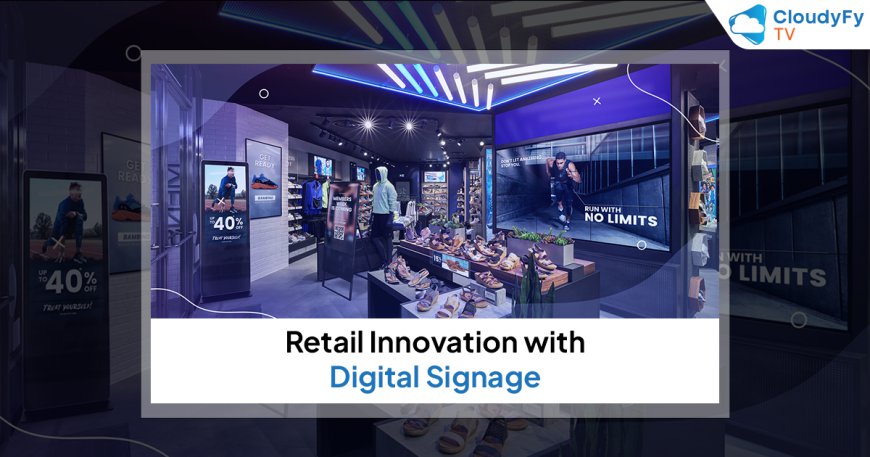How Retail Digital Signage Helps Retailers Adapt to Changing Consumer Preferences and Trends
How Retail Digital Signage Adapts to Consumer Trends| CloudyFy TV

In today's fast-paced retail environment, staying ahead of changing consumer preferences and trends is crucial. Retailers must be agile and responsive to maintain a competitive edge. One powerful tool that has emerged to help retailers achieve this adaptability is digital signage. This blog will explore how digital signage solutions enable retailers to meet evolving consumer demands and trends effectively.
Understanding Digital Signage
Definition and Components
Digital signage refers to electronic displays used to present dynamic content, such as advertisements, product information, and promotional messages. Key components of a digital signage system include the displays themselves, content management systems (CMS), and the software that controls content delivery.
Types of Digital Signage
Digital signage can be classified into various types based on its application:
Indoor vs. Outdoor Signage
Indoor signage is used within retail stores to enhance the shopping experience, while outdoor signage captures the attention of passersby.
Interactive vs. Non-Interactive Displays
Interactive displays allow customers to engage with the content, such as touchscreen kiosks, while non-interactive displays show static or rotating content.
Benefits of Digital Signage in Retail
Enhancing Customer Experience
Digital signage solutions significantly enhance the customer experience by delivering personalized content. Retailers can use digital displays to showcase tailored promotions and offers, making the shopping experience more relevant and engaging for each customer. Interactive digital signage, such as touchscreens, allows customers to explore product information and reviews, further enriching their shopping journey.
Real-Time Content Updates
One of the standout advantages of retail digital signage is the ability to update content in real-time. This flexibility means retailers can quickly respond to emerging trends and seasonal changes, ensuring that their marketing messages are always current and relevant.
Improved Engagement and Attention
High-definition visuals and motion graphics used in digital signage capture customers' attention more effectively than traditional static signage. This increased engagement can lead to higher foot traffic and sales, as customers are more likely to notice and respond to dynamic content.
Data-Driven Insights
Digital signage solutions also provide valuable data-driven insights. By analyzing customer interactions with interactive displays, retailers can gather data on preferences and behaviors. This information can be used to refine marketing strategies and better meet customer needs.
Adapting to Consumer Preferences
Customizing Marketing Messages
Retail digital signage allows for the customization of marketing messages to suit different customer segments. Retailers can create targeted promotions for specific demographics, ensuring that each customer sees content that resonates with their interests and preferences.
Dynamic Content Display
With digital signage, content can be dynamically adjusted based on various factors such as the time of day, season, or special events. This dynamic capability ensures that the displayed content is always relevant and timely, enhancing its effectiveness.
Interactive Features
Interactive digital signage features, such as touchscreens, enable customers to engage directly with the content. This interaction can provide instant access to detailed product information, customer reviews, and even integration with mobile devices for a seamless shopping experience.
Responding to Trends
Agile Marketing Strategies
Digital signage solutions enable retailers to quickly adapt their marketing strategies to market changes. New products and promotional campaigns can be launched swiftly, ensuring that retailers stay ahead of trends and meet consumer demands promptly.
Integration with Social Media
Retail digital signage can be integrated with social media platforms to display user-generated content and real-time social media feeds. This integration encourages online engagement and helps promote brand-related hashtags, bridging the gap between online and offline marketing efforts.
Leveraging Emerging Technologies
Emerging technologies such as augmented reality (AR) and virtual reality (VR) can be incorporated into digital signage solutions to create immersive and personalized shopping experiences. Additionally, artificial intelligence (AI) can be used to provide tailored recommendations based on customer data.
Case Studies
Successful Implementations
Several retailers have successfully implemented digital signage solutions, achieving significant benefits. For example, a major clothing retailer used interactive touchscreens to allow customers to browse and select outfits, resulting in increased customer satisfaction and sales.
Lessons Learned
While the benefits of digital signage are clear, there are also lessons to be learned from its implementation. Challenges such as ensuring content relevance and managing technical issues must be addressed. However, the overall best practices include continuous content updates and leveraging data insights for strategic decisions.
Conclusion
In conclusion, digital signage is a powerful tool for retailers looking to adapt to changing consumer preferences and trends. By enhancing customer experiences, enabling real-time content updates, and providing data-driven insights, digital signage solutions help retailers stay ahead in a competitive market.
For retailers interested in embracing this technology, solutions like CloudyFy TV offer comprehensive digital signage platforms that integrate the latest advancements, ensuring seamless and effective implementation. Investing in digital signage is a strategic move that promises to keep retailers agile and responsive to the ever-evolving retail landscape.
